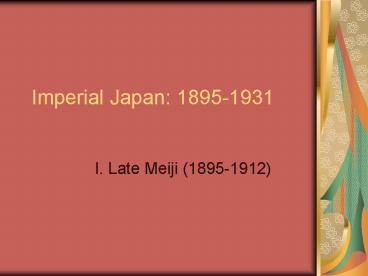Imperial Japan: 18951931 - PowerPoint PPT Presentation
1 / 20
Title:
Imperial Japan: 18951931
Description:
Review Sino-Japanese War ends with the Treaty of Shimonoseki (1895) ... Japanese assume tripe intervention a ploy to deny Japan territory ... – PowerPoint PPT presentation
Number of Views:555
Avg rating:3.0/5.0
Title: Imperial Japan: 18951931
1
Imperial Japan 1895-1931
- I. Late Meiji (1895-1912)
2
Foreign Policy and Empire Building
- Aim to achieve national security and equality of
national status - Japanese colonialism
- Korea as a dagger pointed at the heart of Japan
- Admiral Alfred T. Mahan
- Status, economic, and strategic
- End of Extraterritoriality
3
Japanese Expansion in China
- Review Sino-Japanese War ends with the Treaty of
Shimonoseki (1895) - Japans economic presence increases Exports,
right to build factories - Japanese outrage over Triple Intervention
increase military spending
4
Origins of Russo-Japanese War
- 1896 Russia runs tracks across Manchuria directly
to Vladivostok - 1898 Obtains lease on Port Arthur on Liaodong
Peninsula - Japanese assume tripe intervention a ploy to deny
Japan territory - Russia sides with anti-Japanese forces in Korea
- Japan prepares for War forms alliance with Great
Britain - Remain neutral in war against a single power but
join if against multiple powers
5
Russo-Japanese War (1904-1905)
- Fought on land (mostly Manchuria) and at Sea
- Japan destroyed Russian navy in two spectacular
battles - Japan gains new respect from Asians and Westerns
- TR invites belligerents to Portsmouth New
Hampshire
6
Portsmouth Treaty
- Russia recognizes Japanese supremacy in Korea
- Transfer of Russian interests in Manchuria
- Cedes half of Sakhalin Islands
- Significance
- Japanese expansion into Manchuria
- South Manchurian Railway Company
- Korea forced to become Japanese Protectorate
7
The Loss of Korean Independence and Colonial Rule
- 1896-1945
8
19th Century Background
- 1876 Treaty of Kanghwa
- Using gunboat diplomacy Japan imposes on Korea an
unequal treaty opening up commercial relations - 1884 Kapsin Coup the Li-Ito Convention
- 1894 Sino-Japanese War
- 1894 Kabo Reforms
9
Kabo Reforms
- Following the Sino-Japanese War series of
sweeping reforms instituted by Japanese and
Pro-Japanese modernizers Court dominated by
Japan - Leaders of Kapsin coup appointed to head
government ministries - Establishment of Modern Government
- Abolished the Civil Service Exam
- Attempted to eliminate class distinctions and
slavery
10
Reaction to Kabo Reforms
- Queen Min and Min clan lead opposition movement
to modernization resentment against leaders of
Kapsin coup - 1895 Queen Min assassinated by Japanese thugs and
soldiers in the Palace - King takes additional steps to modernize
including edict to cut off topknot - Riots from Confucianists growing pressure for
Russia
11
Transition to Colonial Rule
- 1896 King escapes from palace flees to Russian
embassy - Dismissed reform cabinet
- New cabinet reverses reforms edicts
- Russia begins to dominate in Korea displacing
Japan - Russo-Japanese War (1904-1905)
- Taft-Katusura Agreement
- violates terms of Treaty of Amity and Commerce
signed with United States
12
Protectorate
- Japan appoints advisors in all Korean ministries
- November 1905 establishes protectorate Emperor
Kojong and ministers refuse to sign treaty - Ito Hirobumi appointed resident general directly
responsible to Emperor - Maintain independent Korea opposes
colonization
13
Annexation of Korea
- Appeals sent to heads of foreign states and to
the Hague - 1907 Kojong persuaded to appoint crown prince
acting monarch - Riots break out Korean military disbanded
- August 22, 1910 Korea forced to signed treaty of
annexation
14
II. The Taisho Period (1912-1926) and the 1920s
15
Taisho Political Crisis (1912-1913)
- Financial conditions force cuts in spending
- Unable to fund domestic program and new divisions
in military - Prime Minister Saionji forced out of office
- Mass demonstrations
- Attempt at imperial order fails
- Significance first time party majority, back by
popular opinion, had overthrew a cabinet
16
Japan during World War I
- August 1914 Japan declares war on Germany seizes
German holdings in China - January 1915 presents 21 demands to China gains
additional concessions but stirs up Chinese
protest - Japanese attempt to prevent Bolshevik return to
Eastern Siberia - Japanese economy booms becomes creditor nation
- Wages did not keep up with inflation leads to
rice riots
17
Washington Conference
- Four Power Pact France, Great Britain, Japan,
and the United States - Limit construction of capital ships to fixed
ratio - 355
- Policy of conciliation with United States and
China
18
Tokyo-Yokohama Devastation
- September 1923
- Earthquake and fires
- Mob violence against Koreans
- Police round up socialists, anarchists, and
Communists as security measure
19
Origins of Japanese Fascism
- Tanaka departs from conciliatory approach sends
troops to Shandong - June 1928 Japanese Army officers assassinate
Zhang Zuolin - Harbinger of future unilateral army actions
20
Video Resources
- Road to Infamy (Video D-18)































